Page 485 of 601
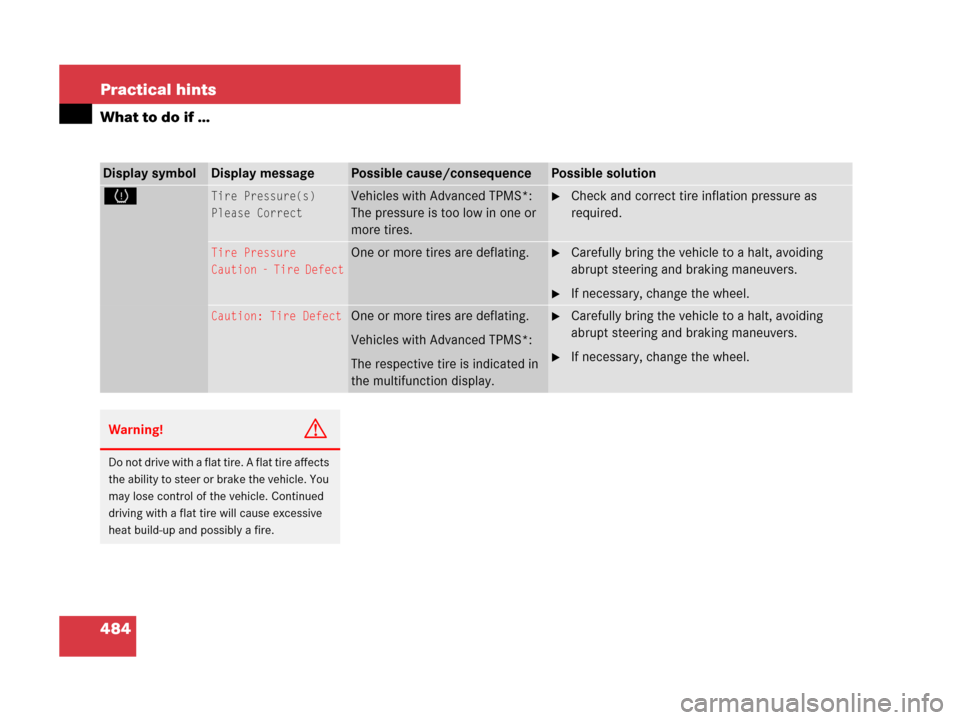
484 Practical hints
What to do if …
Display symbolDisplay messagePossible cause/consequencePossible solution
HTire Pressure(s)
Please CorrectVehicles with Advanced TPMS*:
The pressure is too low in one or
more tires.�Check and correct tire inflation pressure as
required.
Tire Pressure
Caution - Tire DefectOne or more tires are deflating.�Carefully bring the vehicle to a halt, avoiding
abrupt steering and braking maneuvers.
�If necessary, change the wheel.
Caution: Tire DefectOne or more tires are deflating.
Vehicles with Advanced TPMS*:
The respective tire is indicated in
the multifunction display.�Carefully bring the vehicle to a halt, avoiding
abrupt steering and braking maneuvers.
�If necessary, change the wheel.
Warning!G
Do not drive with a flat tire. A flat tire affects
the ability to steer or brake the vehicle. You
may lose control of the vehicle. Continued
driving with a flat tire will cause excessive
heat build-up and possibly a fire.
164.boo Seite 484 Freitag, 30. März 2007 12:54 12
Page 486 of 601
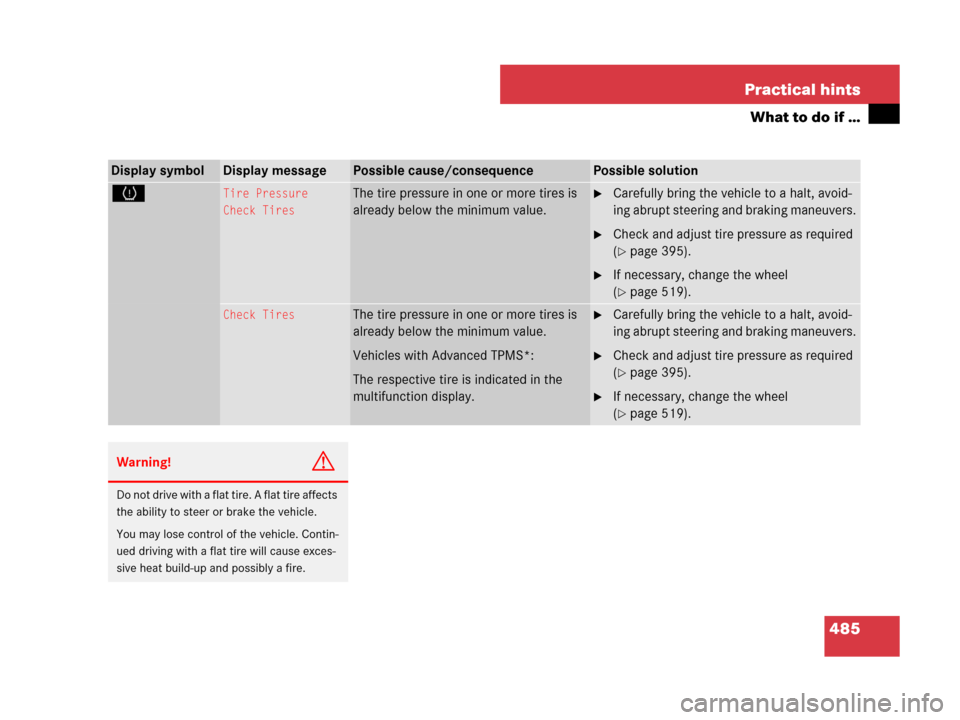
485 Practical hints
What to do if …
Display symbolDisplay messagePossible cause/consequencePossible solution
HTire Pressure
Check TiresThe tire pressure in one or more tires is
already below the minimum value.�Carefully bring the vehicle to a halt, avoid-
ing abrupt steering and braking maneuvers.
�Check and adjust tire pressure as required
(
�page 395).
�If necessary, change the wheel
(
�page 519).
Check TiresThe tire pressure in one or more tires is
already below the minimum value.
Vehicles with Advanced TPMS*:
The respective tire is indicated in the
multifunction display.�Carefully bring the vehicle to a halt, avoid-
ing abrupt steering and braking maneuvers.
�Check and adjust tire pressure as required
(
�page 395).
�If necessary, change the wheel
(
�page 519).
Warning!G
Do not drive with a flat tire. A flat tire affects
the ability to steer or brake the vehicle.
You may lose control of the vehicle. Contin-
ued driving with a flat tire will cause exces-
sive heat build-up and possibly a fire.
164.boo Seite 485 Freitag, 30. März 2007 12:54 12
Page 495 of 601
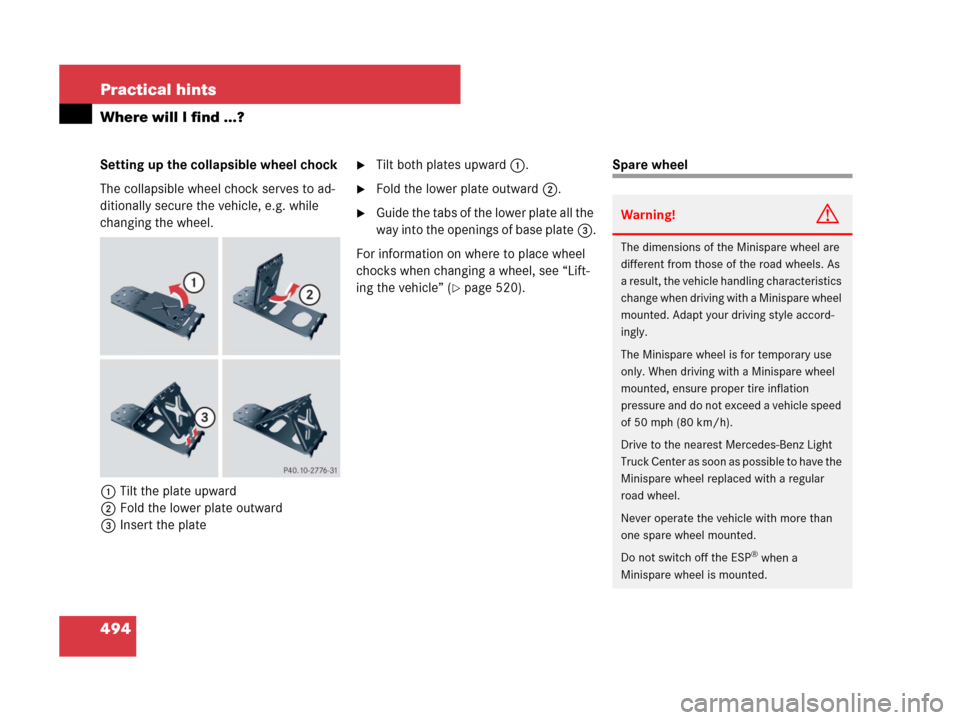
494 Practical hints
Where will I find ...?
Setting up the collapsible wheel chock
The collapsible wheel chock serves to ad-
ditionally secure the vehicle, e.g. while
changing the wheel.
1Tilt the plate upward
2Fold the lower plate outward
3Insert the plate�Tilt both plates upward1.
�Fold the lower plate outward2.
�Guide the tabs of the lower plate all the
way into the openings of base plate3.
For information on where to place wheel
chocks when changing a wheel, see “Lift-
ing the vehicle” (
�page 520).
Spare wheel
Warning!G
The dimensions of the Minispare wheel are
different from those of the road wheels. As
a result, the vehicle handling characteristics
change when driving with a Minispare wheel
mounted. Adapt your driving style accord-
ingly.
The Minispare wheel is for temporary use
only. When driving with a Minispare wheel
mounted, ensure proper tire inflation
pressure and do not exceed a vehicle speed
of 50 mph (80 km/h).
Drive to the nearest Mercedes-Benz Light
Truck Center as soon as possible to have the
Minispare wheel replaced with a regular
road wheel.
Never operate the vehicle with more than
one spare wheel mounted.
Do not switch off the ESP
® when a
Minispare wheel is mounted.
164.boo Seite 494 Freitag, 30. März 2007 12:54 12
Page 520 of 601
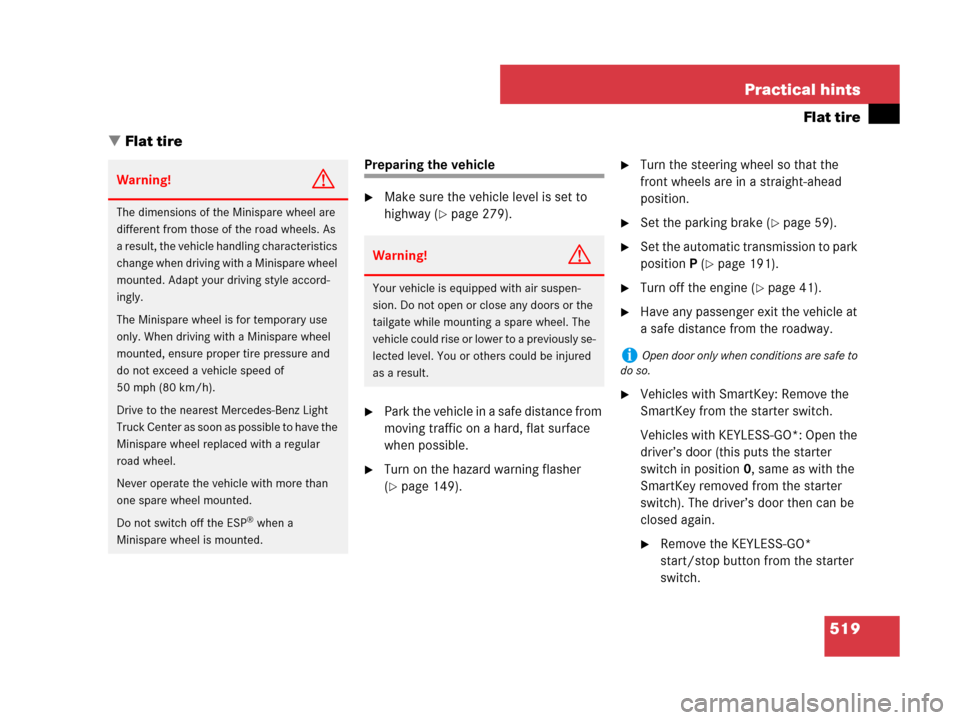
519 Practical hints
Flat tire
�Flat tire
Preparing the vehicle
�Make sure the vehicle level is set to
highway (
�page 279).
�Park the vehicle in a safe distance from
moving traffic on a hard, flat surface
when possible.
�Turn on the hazard warning flasher
(
�page 149).
�Turn the steering wheel so that the
front wheels are in a straight-ahead
position.
�Set the parking brake (�page 59).
�Set the automatic transmission to park
positionP (
�page 191).
�Turn off the engine (�page 41).
�Have any passenger exit the vehicle at
a safe distance from the roadway.
�Vehicles with SmartKey: Remove the
SmartKey from the starter switch.
Vehicles with KEYLESS-GO*: Open the
driver’s door (this puts the starter
switch in position0, same as with the
SmartKey removed from the starter
switch). The driver’s door then can be
closed again.
�Remove the KEYLESS-GO*
start/stop button from the starter
switch.
Warning!G
The dimensions of the Minispare wheel are
different from those of the road wheels. As
a result, the vehicle handling characteristics
change when driving with a Minispare wheel
mounted. Adapt your driving style accord-
ingly.
The Minispare wheel is for temporary use
only. When driving with a Minispare wheel
mounted, ensure proper tire pressure and
do not exceed a vehicle speed of
50 mph (80 km/h).
Drive to the nearest Mercedes-Benz Light
Truck Center as soon as possible to have the
Minispare wheel replaced with a regular
road wheel.
Never operate the vehicle with more than
one spare wheel mounted.
Do not switch off the ESP
® when a
Minispare wheel is mounted.
Warning!G
Your vehicle is equipped with air suspen-
sion. Do not open or close any doors or the
tailgate while mounting a spare wheel. The
vehicle could rise or lower to a previously se-
lected level. You or others could be injured
as a result.
iOpen door only when conditions are safe to
do so.
164.boo Seite 519 Freitag, 30. März 2007 12:54 12
Page 521 of 601
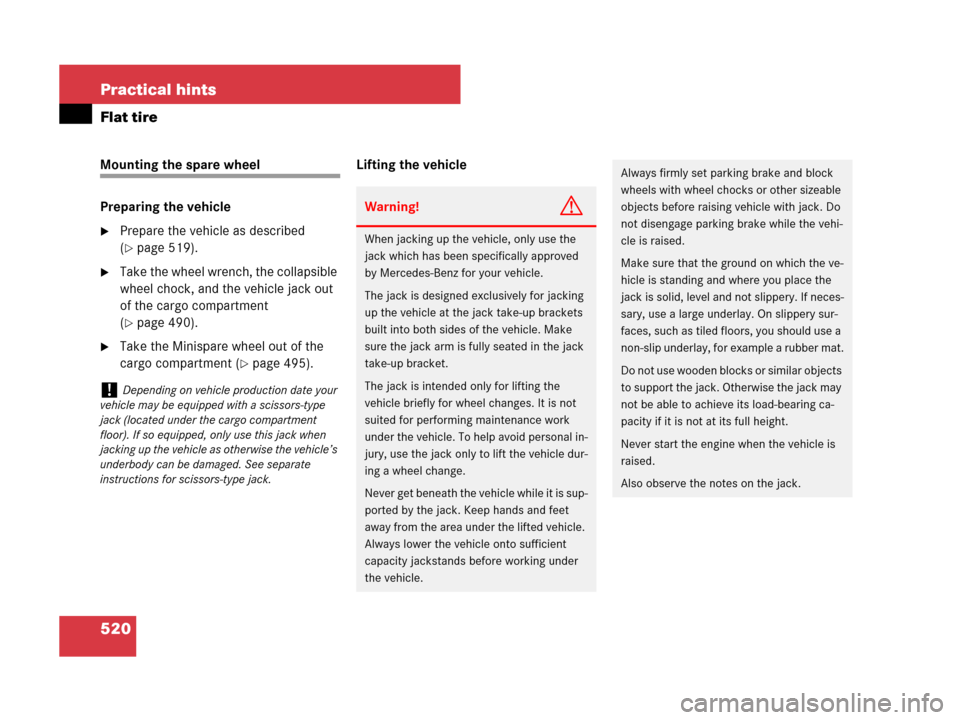
520 Practical hints
Flat tire
Mounting the spare wheel
Preparing the vehicle
�Prepare the vehicle as described
(
�page 519).
�Take the wheel wrench, the collapsible
wheel chock, and the vehicle jack out
of the cargo compartment
(
�page 490).
�Take the Minispare wheel out of the
cargo compartment (
�page 495).Lifting the vehicle
!Depending on vehicle production date your
vehicle may be equipped with a scissors-type
jack (located under the cargo compartment
floor). If so equipped, only use this jack when
jacking up the vehicle as otherwise the vehicle’s
underbody can be damaged. See separate
instructions for scissors-type jack.
Warning!G
When jacking up the vehicle, only use the
jack which has been specifically approved
by Mercedes-Benz for your vehicle.
The jack is designed exclusively for jacking
up the vehicle at the jack take-up brackets
built into both sides of the vehicle. Make
sure the jack arm is fully seated in the jack
take-up bracket.
The jack is intended only for lifting the
vehicle briefly for wheel changes. It is not
suited for performing maintenance work
under the vehicle. To help avoid personal in-
jury, use the jack only to lift the vehicle dur-
ing a wheel change.
Never get beneath the vehicle while it is sup-
ported by the jack. Keep hands and feet
away from the area under the lifted vehicle.
Always lower the vehicle onto sufficient
capacity jackstands before working under
the vehicle.
Always firmly set parking brake and block
wheels with wheel chocks or other sizeable
objects before raising vehicle with jack. Do
not disengage parking brake while the vehi-
cle is raised.
Make sure that the ground on which the ve-
hicle is standing and where you place the
jack is solid, level and not slippery. If neces-
sary, use a large underlay. On slippery sur-
faces, such as tiled floors, you should use a
non-slip underlay, for example a rubber mat.
Do not use wooden blocks or similar objects
to support the jack. Otherwise the jack may
not be able to achieve its load-bearing ca-
pacity if it is not at its full height.
Never start the engine when the vehicle is
raised.
Also observe the notes on the jack.
164.boo Seite 520 Freitag, 30. März 2007 12:54 12
Page 522 of 601
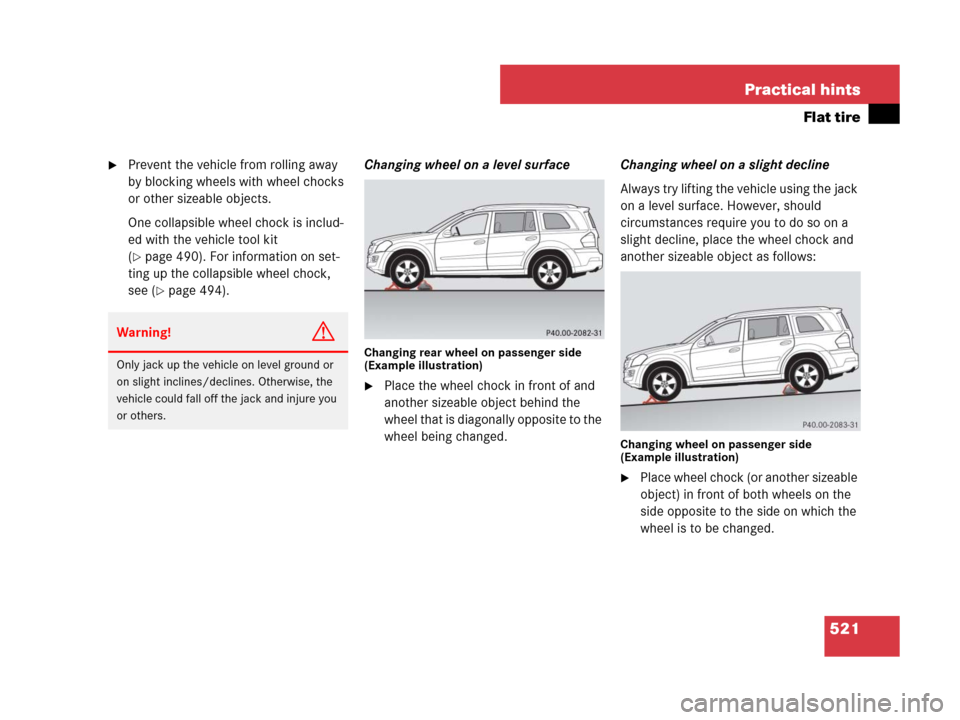
521 Practical hints
Flat tire
�Prevent the vehicle from rolling away
by blocking wheels with wheel chocks
or other sizeable objects.
One collapsible wheel chock is includ-
ed with the vehicle tool kit
(
�page 490). For information on set-
ting up the collapsible wheel chock,
see (
�page 494).Changing wheel on a level surface
Changing rear wheel on passenger side
(Example illustration)
�Place the wheel chock in front of and
another sizeable object behind the
wheel that is diagonally opposite to the
wheel being changed.Changing wheel on a slight decline
Always try lifting the vehicle using the jack
on a level surface. However, should
circumstances require you to do so on a
slight decline, place the wheel chock and
another sizeable object as follows:
Changing wheel on passenger side
(Example illustration)
�Place wheel chock (or another sizeable
object) in front of both wheels on the
side opposite to the side on which the
wheel is to be changed.
Warning!G
Only jack up the vehicle on level ground or
on slight inclines/declines. Otherwise, the
vehicle could fall off the jack and injure you
or others.
164.boo Seite 521 Freitag, 30. März 2007 12:54 12
Page 523 of 601
522 Practical hints
Flat tire
Changing wheel on a slight incline
Always try lifting the vehicle using the jack
on a level surface. However, should
circumstances require you to do so on a
slight incline, place the wheel chock and
another sizeable object as follows:
Changing wheel on passenger side
(Example illustration)
�Place wheel chock (or another sizeable
object) behind both wheels on the side
opposite to the side on which the wheel
is to be changed.1Wheel wrench
�On wheel to be changed, loosen but do
not yet remove the wheel bolts
(approximately one full turn with wheel
wrench1).The jack take-up brackets are located
directly behind the front wheel housings
and in front of the rear wheel housings as
indicated by the arrows.
164.boo Seite 522 Freitag, 30. März 2007 12:54 12
Page 524 of 601
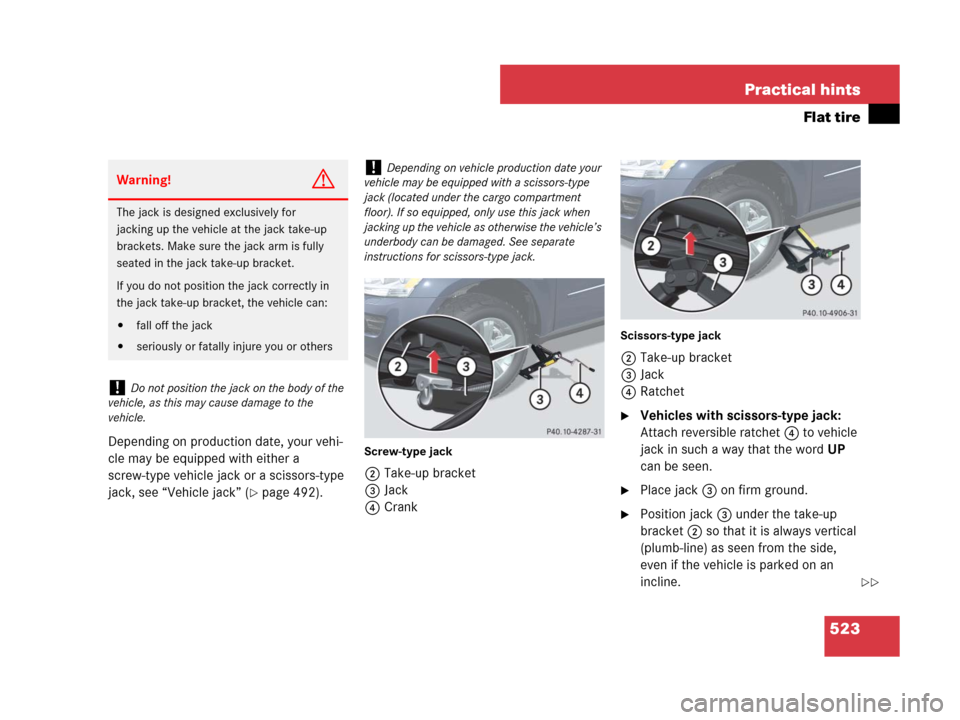
523 Practical hints
Flat tire
Depending on production date, your vehi-
cle may be equipped with either a
screw-type vehicle jack or a scissors-type
jack, see “Vehicle jack” (
�page 492).
Screw-type jack
2Take-up bracket
3Jack
4Crank
Scissors-type jack
2Take-up bracket
3Jack
4Ratchet
�Vehicles with scissors-type jack:
Attach reversible ratchet4 to vehicle
jack in such a way that the wordUP
can be seen.
�Place jack3 on firm ground.
�Position jack3 under the take-up
bracket2 so that it is always vertical
(plumb-line) as seen from the side,
even if the vehicle is parked on an
incline.
Warning!G
The jack is designed exclusively for
jacking up the vehicle at the jack take-up
brackets. Make sure the jack arm is fully
seated in the jack take-up bracket.
If you do not position the jack correctly in
the jack take-up bracket, the vehicle can:
�fall off the jack
�seriously or fatally injure you or others
!Do not position the jack on the body of the
vehicle, as this may cause damage to the
vehicle.
!Depending on vehicle production date your
vehicle may be equipped with a scissors-type
jack (located under the cargo compartment
floor). If so equipped, only use this jack when
jacking up the vehicle as otherwise the vehicle’s
underbody can be damaged. See separate
instructions for scissors-type jack.
��
164.boo Seite 523 Freitag, 30. März 2007 12:54 12